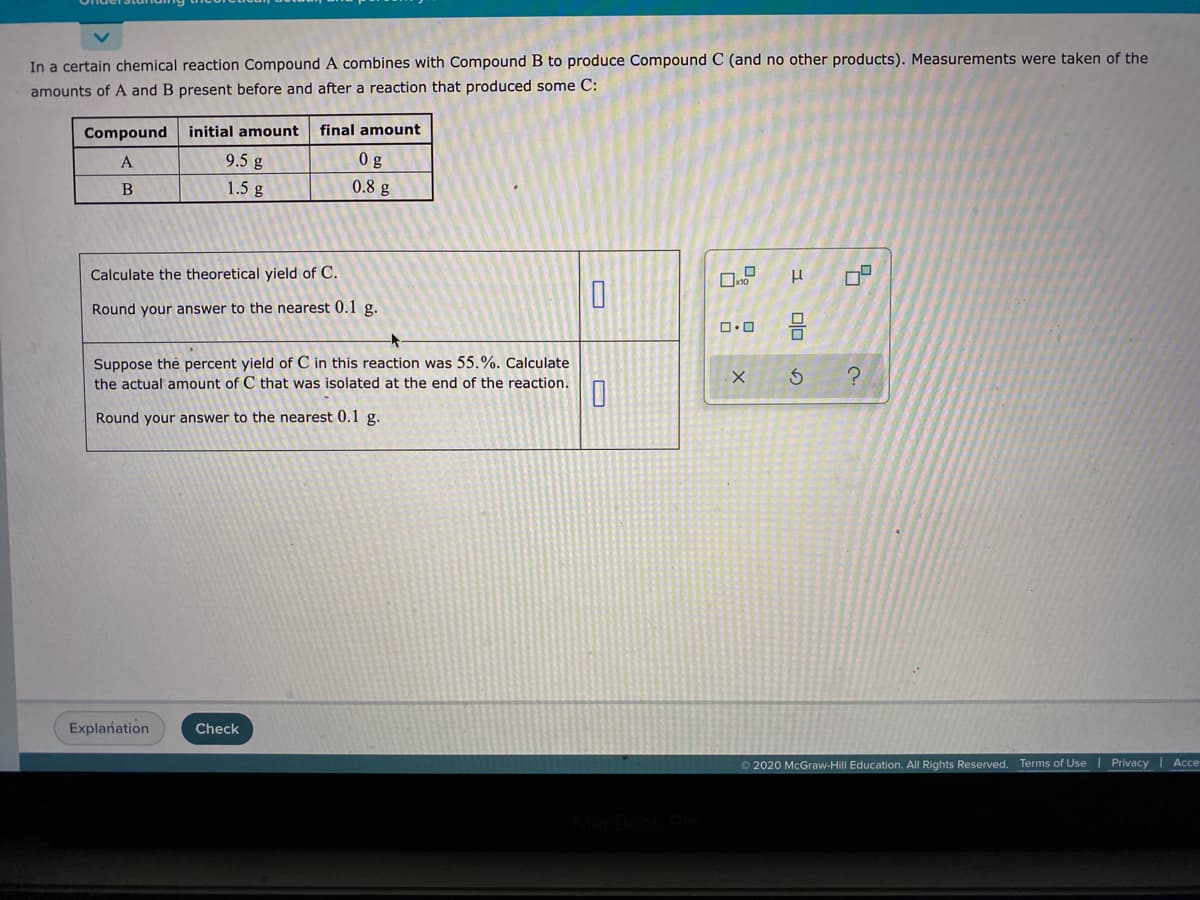In a certain chemical reaction Compound A combines with Compound B to produce Compound C (and no other products). Measurements were taken of the amounts of A and B present before and after a reaction that produced some C: Compound initial amount final amount A 9.5 g 0g 1.5 g 0.8 g Calculate the theoretical yield of C. Round your answer to the nearest 0.1 g. Suppose thẻ percent yield of C in this reaction was 55.%. Calculate the actual amount of C that was isolated at the end of the reaction. Round your answer to the nearest 0.1 g.
In a certain chemical reaction Compound A combines with Compound B to produce Compound C (and no other products). Measurements were taken of the amounts of A and B present before and after a reaction that produced some C: Compound initial amount final amount A 9.5 g 0g 1.5 g 0.8 g Calculate the theoretical yield of C. Round your answer to the nearest 0.1 g. Suppose thẻ percent yield of C in this reaction was 55.%. Calculate the actual amount of C that was isolated at the end of the reaction. Round your answer to the nearest 0.1 g.
Chemistry: Matter and Change
1st Edition
ISBN:9780078746376
Author:Dinah Zike, Laurel Dingrando, Nicholas Hainen, Cheryl Wistrom
Publisher:Dinah Zike, Laurel Dingrando, Nicholas Hainen, Cheryl Wistrom
Chapter11: Stoichiometry
Section: Chapter Questions
Problem 96A
Related questions
Question

Transcribed Image Text:In a certain chemical reaction Compound A combines with Compound B to produce Compound C (and no other products). Measurements were taken of the
amounts of A and B present before and after a reaction that produced some C:
Compound initial amount
final amount
A
9.5 g
0 g
1.5 g
0.8 g
Calculate the theoretical yield of C.
Round your answer to the nearest 0.1 g.
Suppose thẻ percent yield of C in this reaction was 55.%. Calculate
the actual amount of C that was isolated at the end of the reaction.
Round your answer to the nearest 0.1 g.
Explañation
Check
O 2020 McGraw-Hill Education. All Rights Reserved. Terms of Use | Privacy Ace
olo
Expert Solution
This question has been solved!
Explore an expertly crafted, step-by-step solution for a thorough understanding of key concepts.
This is a popular solution!
Trending now
This is a popular solution!
Step by step
Solved in 2 steps

Knowledge Booster
Learn more about
Need a deep-dive on the concept behind this application? Look no further. Learn more about this topic, chemistry and related others by exploring similar questions and additional content below.Recommended textbooks for you

Chemistry: Matter and Change
Chemistry
ISBN:
9780078746376
Author:
Dinah Zike, Laurel Dingrando, Nicholas Hainen, Cheryl Wistrom
Publisher:
Glencoe/McGraw-Hill School Pub Co

Principles of Modern Chemistry
Chemistry
ISBN:
9781305079113
Author:
David W. Oxtoby, H. Pat Gillis, Laurie J. Butler
Publisher:
Cengage Learning

Introductory Chemistry: A Foundation
Chemistry
ISBN:
9781337399425
Author:
Steven S. Zumdahl, Donald J. DeCoste
Publisher:
Cengage Learning

Chemistry: Matter and Change
Chemistry
ISBN:
9780078746376
Author:
Dinah Zike, Laurel Dingrando, Nicholas Hainen, Cheryl Wistrom
Publisher:
Glencoe/McGraw-Hill School Pub Co

Principles of Modern Chemistry
Chemistry
ISBN:
9781305079113
Author:
David W. Oxtoby, H. Pat Gillis, Laurie J. Butler
Publisher:
Cengage Learning

Introductory Chemistry: A Foundation
Chemistry
ISBN:
9781337399425
Author:
Steven S. Zumdahl, Donald J. DeCoste
Publisher:
Cengage Learning

Chemistry: The Molecular Science
Chemistry
ISBN:
9781285199047
Author:
John W. Moore, Conrad L. Stanitski
Publisher:
Cengage Learning

Chemistry: Principles and Reactions
Chemistry
ISBN:
9781305079373
Author:
William L. Masterton, Cecile N. Hurley
Publisher:
Cengage Learning

Chemistry by OpenStax (2015-05-04)
Chemistry
ISBN:
9781938168390
Author:
Klaus Theopold, Richard H Langley, Paul Flowers, William R. Robinson, Mark Blaser
Publisher:
OpenStax